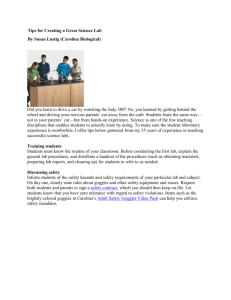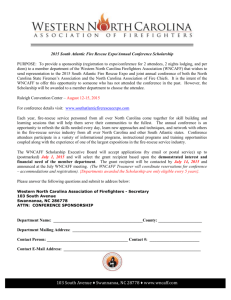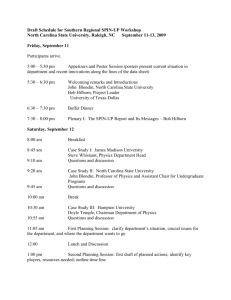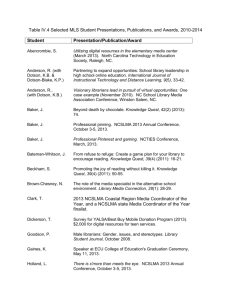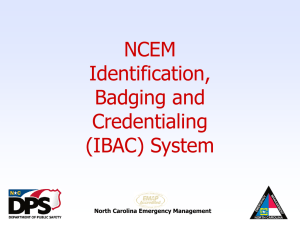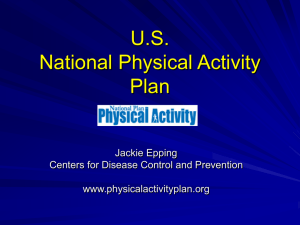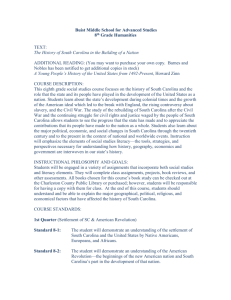Now That You Are the Fire Chief - North Carolina Department of
advertisement
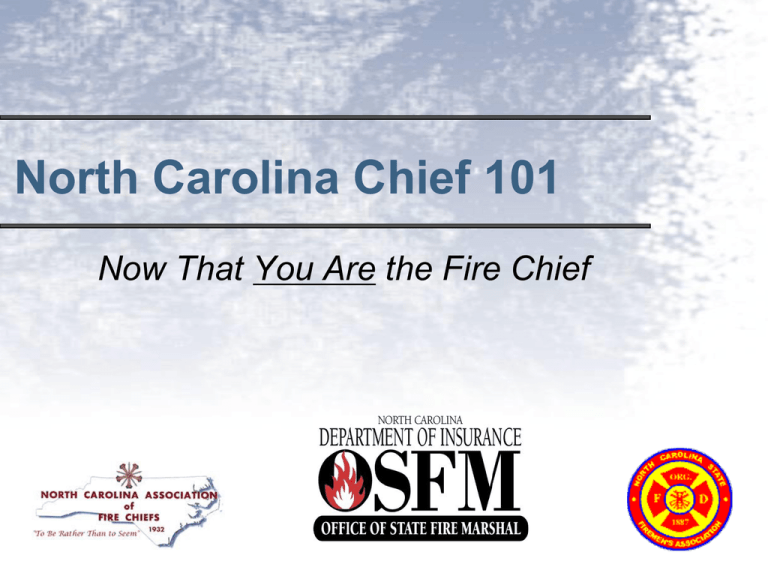
North Carolina Chief 101 Now That You Are the Fire Chief Course Objectives • This presentation is the first program of the Chief 101 class which will satisfy the 9s inspection criteria as specified by the North Carolina Administrative Code. The primary objective of the course is to inform current and future chief officers of the various aspects and complexities surrounding the operations and organization of North Carolina fire departments. These programs also provide contact information and web links to help officers find more information. Program Objectives Provide an general overview of expectations facing a chief officer Other programs cover more information on: – – – – – – Ratings and Inspections, NFIRS reporting, Firefighter Health and Safety Grant and Relief Programs Line-of-Duty Death Handling Financial Considerations Now that You are the Fire Chief The Responsibilities Are Yours Remember when you use to say, “If I was the Chief, I would….” Now That You Are the Fire Chief There is always one person held accountable for the success or failure of any organization – – – – – U. S. Government – The President Church – The Pastor Law Enforcement – The Police Chief Local Governments – County/City Manager Fire Department – That’s You “THE FIRE CHIEF” Now that You are the Fire Chief What are Your Primary Responsibilities? – “To Save Lives and Protect Property” • Response Personnel • Citizens – Emergency Services Response – The Safety of Your Personnel • • • • Training Personal Protection Personal Accountability Enforcing Safety Standards Now That You Are the Fire Chief Truly evaluate your department’s response and readiness capabilities – Is your membership protected? – Can you deliver what you say you can? – Are your responders trained properly and do they follow the department’s training standards? – Do you have written, updated Standard Operating Guidelines? – Are your department records current? Now That You Are the Fire Chief REMEMBER – YOU ARE NOW RESPONSIBLE DELEGATING OR ASSUMING DOES NOT RELIEVE YOU OF THE RESPONSIBILITY FOR KNOWING Is Your Membership Protected? Is your Roster Up-To-Date? Is there a process for updating your Roster as members are added or deleted? THE ROSTER IS A LIVING DOCUMENT AND SHOULD BE UPDATED AS CHANGES OCCUR, NOT TOMORROW!! Is Your Membership Protected? Consequences of not having a current roster: – Members are not available for NCSFA Benefits. – In the event of a firefighter death, family members are not eligible for NCSFA death benefits, possibly resulting in the Fire Chief and Department facing civil action. – Individuals are not eligible for North Carolina State Firemen’s Association Benefits (http://www.ncsfa.com) Can You Deliver? Fire Suppression Emergency Medical Services Vehicle Extrication Water Rescue Hazard Materials Response Your local officials most likely assume that you can provide all these services Now That You Are the Fire Chief • Identify what the hazards are in your community and inform the local officials of the department's capabilities to respond to hazards in your response area. – “The Routine Response” • Contrary to popular belief, “We can not be all things in all situations” • There are risk that fire departments are not equipped to deal with and we should let local officials know before we are faced with the incident • While this may not change frequently in many areas, it should be part of an annual review during the budget process. Now You Are the Chief Critical that you provide an assessment of the department’s readiness – especially to successors – The reputation of the past chief can be a positive with the community, but a negative within the organization or vice versa – “You can only rely on past success until the next alarm” Are Your Responders Ready? Standard Training Requirements – Must offer 48 hours of drills and meetings as a minimum for 9S. – Pension Fund and Death Benefit Qualification – a member must have 36 Hours – Hazardous Materials – 8 Hours – EMT Continuing Education – 24 Hours minimum Are Your Responders Ready? NCRRS Requirements (below 9 rating) – – – – – – – – Recruit Training– 240 Hours New Driver/Operator- 40 hours Driver/Operator Recurring – 12 hours Officer – 12 Hours Multiple Company Training – 4 sessions of 3 hours Night Evolutions- 2 sessions 3 hours Haz Mat Training- 3 hours Company Training 20 hours per person per month. Standard Training Requirements vs. Application of Techniques Meeting “Standard Hours” in reality has only an administrative meaning. It does nothing to show if a firefighter really knows how to apply what he/she has been exposed to. Classroom exposure is essential to development, but it does not replace the need to conduct hands on drills Adopt the State of Missouri’s slogan, “Show Me” Standard Training Requirements vs. Application of Techniques The Chief and the department need to identify minimum requirements that the department will accept for each position After identifying minimum requirements there needs to be a manner to evaluate each persons actual skills and abilities. Question – Should you accept “Yes” to your question of, “Do you know how to….” Topics for this course Resources available to you Various Associations in the state Firemen’s Relief Fund Junior Members LODD NFIRS Important dates Associations/Agencies North Carolina Association of Fire Chiefs North Carolina State Firemen’s Association North Carolina Fire Marshals Association North Carolina Association of Rescue and EMS North Carolina Society of Fire and Rescue Instructors Fire and Life Safety Educators Associations/Agencies North Carolina Association of Hazardous Materials Responders State Emergency Response Commission Office of the State Fire Marshal North Carolina Community Colleges Office of Emergency Medical Services North Carolina Emergency Management Local Relief Fund Report(s) Report is requested by October 31 and no later than January 1 of each year (link to NCSFA website) Consequences for not reporting - Loss of eligibility for future Relief Funds Conflict of Interest Statement to OSFM Organizational Development What do you want your people to know how to do? What are your expectations for each level or rank within your department? Each answer will differ from department to department. The Cheat Sheet (Important Dates) Visit the Pocket Tools site for a downloadable “cheat sheet” that you can use as a resource.

